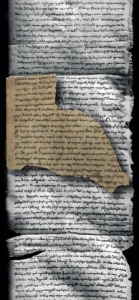David the Builder’s Testament & New Exhibits of Medieval Treasury
From December 26, 2016, the Georgian National Museum, National Archives of Georgia and Korneli Kekelidze National Center of Manuscripts are offering a renewed exhibition of the Medieval Treasury.
The Simon Janashia Museum of Georgia is now giving visitors the possibility to see a fragment of the only surviving testament of David the Builder, written in Sharvan before combat, and also a copy of its glass negative made by Aleksandre Roinashvili in 1895. The exhibition also showcases paleographical blades of David the Builder's handicrafts created by Sargis Kakabadze in 1911.
Visitors also have a chance to view the richly embellished gospel "Ceremonial" (Sazeimo) which in all likelihood belonged to Queen Tamar; one of the earliest monuments from the classical period of Georgian medicine, the XIII-XIV centuries encyclopedic work "Incomparable Book of Medicine" (Ustsoro Karabadini); the code type list - Vale Gospels (1514) copied in the scriptorium of the Atabag Family from Samtskhe; Georgian Chronicles copied on the order of Mariam Dadiani, the wife of King Rostom; and more!
These exhibits make up just part of the exhibition Medieval Treasury, which showcases Georgian Christian art reflecting the unity and continuity of cultural traditions and forming the basis of Georgian statehood and national identity.
Georgian Christian art is based on pre-Christian traditions which eventually formed the nation. Located at the crossroads of cultural movements from East and west, Georgia showed alacrity to accept advanced headways. Georgia was one of the first countries to adopt Christianity and recognize it as the national religion, a decision which tied the country closer to Europe and European culture.
The exhibition space of the Medieval Treasury, equipped according to international standards, was opened in June 2016. As stated by the specifics of the collection, the works will constantly be changed. The exhibition, accompanied by educational programs and cultural activities, gives the opportunity to witness the development and formation of the Georgian national identity.
The central component, David the Builder’s Testament, belongs to the collection of the National Archives.
“This is a marvelous project that unites three institutions,” said Teona Iashvili, Director of the National Archives. “These are two documents of paramount importance from our funds: one is the fragment of Davit the Builder’s testament that survived destruction, and the second is the deed of Vamek Shaburisdze, dating back to the 15th century. It is fantastic that these sparkling halls are hosting the documents of our [institution], together with the collection of the National Museum and that of the National Center of Manuscripts.”
“David the Builder is a symbol of success and unity for many a Georgian,” said Davit Lordkipanidze, Director General of the Georgian National Museum. “I would wish each of us to resemble him in our own professions. I think that it is of utmost importance that the three national institutions are exhibiting such significant documents to society. This permanent exhibition is about the art and history of the medieval era, whose exhibits are changed from time to time to show off different documents. This day demonstrates the richness of our depositories. These exhibits signify that art and science have always been priority spheres in our country, especially in the medieval era, and Georgia was a very strong Christian country then.”
GEORGIA TODAY spoke to Zaza Abashidze, Director of the National Center of Manuscripts.
“This is the continuation of the previous exhibition. However, there is a new format in terms of our refreshed collection,” Abashidze told us. “We had to leave the previous manuscripts on display for longer than allowed but from now on we plan to change our collection every two months to prevent damage. Where, during the first exhibition, there were only two institutions involved – the National Museum and National Center of Manuscripts, this time, the National Archives has joined us with its unique material, too. In future, we are thinking to enlarge our scope even more and hope that the National Library will also be added to our list of participants.”
The Ministry of Culture was the supporter of the project.
“It is the best example of cooperation between the institutions and governmental offices,” said Mikheil Giorgadze, Minister of Culture and Monument Protection.
Where: Simon Janashia Museum of Georgia, 3 Shota Rustaveli Ave. Tbilisi, Georgia.
Maka Lomadze











